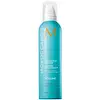What's inside
What's inside
 Key Ingredients
Key Ingredients

No key ingredients
 Benefits
Benefits

 Concerns
Concerns

 Ingredients Side-by-side
Ingredients Side-by-side

Water
Skin ConditioningGlyceryl Stearate
EmollientCetearyl Alcohol
EmollientPropanediol
SolventBehentrimonium Chloride
PreservativeDistearyldimonium Chloride
Stearamidopropyl Dimethylamine
EmulsifyingStearic Acid
CleansingParfum
MaskingIsoamyl Laurate
EmollientSodium Hyaluronate
HumectantPolyquaternium-55
Panthenol
Skin ConditioningButyrospermum Parkii Butter
Skin ConditioningHydroxypropylgluconamide
HumectantHydroxypropylammonium Gluconate
HumectantPolyquaternium-68
Hydrolyzed Adansonia Digitata Seed Extract
Tocopheryl Acetate
AntioxidantCetrimonium Chloride
AntimicrobialGlycerin
HumectantBambusa Arundinacea Stem Extract
Skin ConditioningRosmarinus Officinalis Leaf Extract
AntimicrobialLeuconostoc/Radish Root Ferment Filtrate
AntimicrobialBrassica Campestris/Aleurites Fordi Oil Copolymer
Skin ConditioningTocopherol
AntioxidantSodium Benzoate
MaskingPotassium Sorbate
PreservativeIsopropyl Alcohol
SolventEthylhexylglycerin
Skin ConditioningPhenoxyethanol
PreservativeCitric Acid
BufferingCI 17200
Cosmetic ColorantWater, Glyceryl Stearate, Cetearyl Alcohol, Propanediol, Behentrimonium Chloride, Distearyldimonium Chloride, Stearamidopropyl Dimethylamine, Stearic Acid, Parfum, Isoamyl Laurate, Sodium Hyaluronate, Polyquaternium-55, Panthenol, Butyrospermum Parkii Butter, Hydroxypropylgluconamide, Hydroxypropylammonium Gluconate, Polyquaternium-68, Hydrolyzed Adansonia Digitata Seed Extract, Tocopheryl Acetate, Cetrimonium Chloride, Glycerin, Bambusa Arundinacea Stem Extract, Rosmarinus Officinalis Leaf Extract, Leuconostoc/Radish Root Ferment Filtrate, Brassica Campestris/Aleurites Fordi Oil Copolymer, Tocopherol, Sodium Benzoate, Potassium Sorbate, Isopropyl Alcohol, Ethylhexylglycerin, Phenoxyethanol, Citric Acid, CI 17200
Ingredients Explained
These ingredients are found in both products.
Ingredients higher up in an ingredient list are typically present in a larger amount.
Parfum is a catch-all term for an ingredient or more that is used to give a scent to products.
Also called "fragrance", this ingredient can be a blend of hundreds of chemicals or plant oils. This means every product with "fragrance" or "parfum" in the ingredients list is a different mixture.
For instance, Habanolide is a proprietary trade name for a specific aroma chemical. When used as a fragrance ingredient in cosmetics, most aroma chemicals fall under the broad labeling category of “FRAGRANCE” or “PARFUM” according to EU and US regulations.
The term 'parfum' or 'fragrance' is not regulated in many countries. In many cases, it is up to the brand to define this term.
For instance, many brands choose to label themselves as "fragrance-free" because they are not using synthetic fragrances. However, their products may still contain ingredients such as essential oils that are considered a fragrance by INCI standards.
One example is Calendula flower extract. Calendula is an essential oil that still imparts a scent or 'fragrance'.
Depending on the blend, the ingredients in the mixture can cause allergies and sensitivities on the skin. Some ingredients that are known EU allergens include linalool and citronellol.
Parfum can also be used to mask or cover an unpleasant scent.
The bottom line is: not all fragrances/parfum/ingredients are created equally. If you are worried about fragrances, we recommend taking a closer look at an ingredient. And of course, we always recommend speaking with a professional.
Learn more about ParfumPhenoxyethanol is a preservative that has germicide, antimicrobial, and aromatic properties. Studies show that phenoxyethanol can prevent microbial growth. By itself, it has a scent that is similar to that of a rose.
It's often used in formulations along with Caprylyl Glycol to preserve the shelf life of products.
Potassium Sorbate is a preservative used to prevent yeast and mold in products. It is commonly found in both cosmetic and food products.
This ingredient comes from potassium salt derived from sorbic acid. Sorbic acid is a natural antibiotic and effective against fungus.
Both potassium sorbate and sorbic acid can be found in baked goods, cheeses, dried meats, dried fruit, ice cream, pickles, wine, yogurt, and more.
You'll often find this ingredient used with other preservatives.
Learn more about Potassium SorbateWater. It's the most common cosmetic ingredient of all. You'll usually see it at the top of ingredient lists, meaning that it makes up the largest part of the product.
So why is it so popular? Water most often acts as a solvent - this means that it helps dissolve other ingredients into the formulation.
You'll also recognize water as that liquid we all need to stay alive. If you see this, drink a glass of water. Stay hydrated!
Learn more about Water